Trekking the Himalayas on a whim – alone and with no plan
Follow our new CNA LIFESTYLE page on Facebook for more travel stories and videos
KATHMANDU: "You mean you have no coin?" the immigration officer at Kathmandu's Tribhuvan International Airport asked, clearly annoyed at the fact that I could not pay for my on-arrival tourist visa.
I suppose when yous decide to travel without any accelerate planning, it is easy to overlook the fact that yous oasis't brought enough Singapore dollars with you to pay for something every bit crucial as a visa. Thankfully, afterward much pleading, the officers finally turned on their credit card machine to accept my non-cash payment.
I institute myself on this impromptu trip after i specially sleepless night, when it occurred to me that I'm nevertheless young, healthy and largely commitment-costless. It would be a shame to let my long work hours and the near impossibility of coordinating anything longer than dinner with friends stop me from exploring different pockets of the world.
I could do information technology on my own – and I could do it now.
Before my departure to Nepal, my parents asked me repeatedly what my itinerary looked similar, clearly concerned about their just kid and daughter venturing off on her own.
In reality, my itinerary was essentially a bare slice of newspaper. I knew I wanted to have a vacation, but the idea of planning i seemed cumbersome – and that's how I found myself standing in the heart of Kathmandu's airdrome with my passport, a backpack, a duffel handbag and no idea what to do.
CLIMB A Mount? OK And then
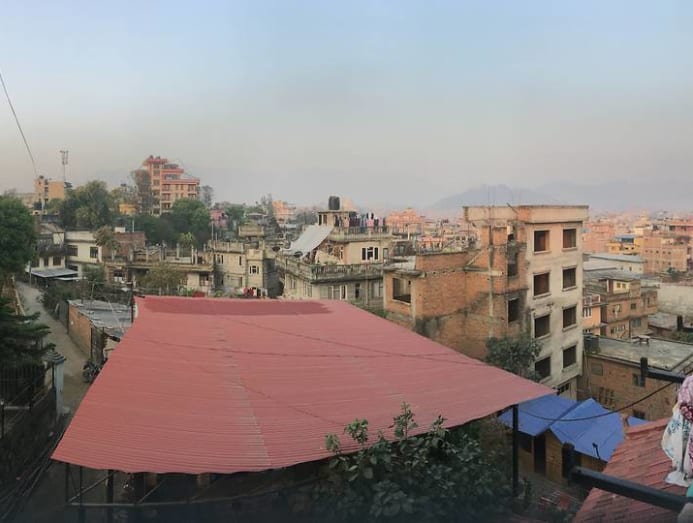
By 7pm on the first night, I had failed to find local Nepalese food around my hostel situated near the tourist hot spot of Thamel, as the streets were lined with European-style cafes that sold questionably soft croissants.
Lazing in bed, I decided – with a slight overestimation of my cardio abilities – that information technology would be a cardinal sin to be so close to the Himalayas and not endeavor to view it up-close.
Full disclosure: Trekking had always been a faint possibility with this trip, and then I had packed a down jacket and altitude sickness pills. I had non, even so, trained for whatever of it.
Less than two hours later, I booked myself a expedition to the Annapurna Base Camp. If I had done any enquiry, I would accept known that this particular trek was not a gradual incline leading to the acme, but a long serial of uphill and downhill treks that I was certainly not set up for.
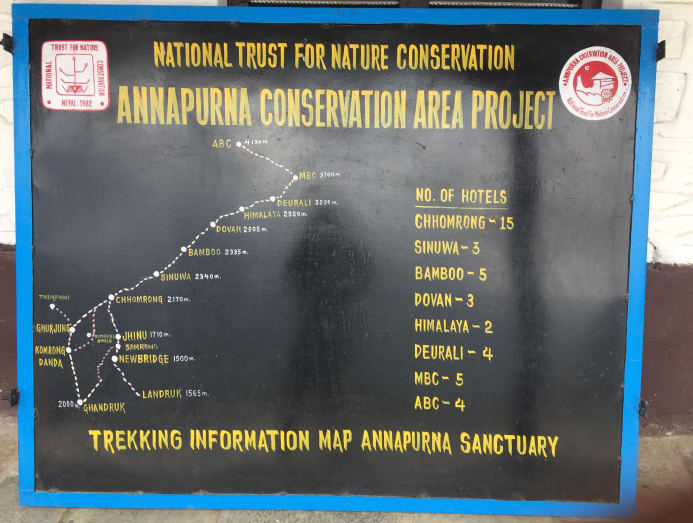
And just like that, I was on a bumpy, nausea-inducing 8-hour double-decker ride with my guide Raj to Pokhara, en route to Nayapul, where the expedition would begin. Forth the course of seven days, we would trek uphill to the acme, while passing villages in areas like Ulleri, Ghorepani, Chuile, Sinuwa and Deurali.
These villages have tea houses, the almost common type of accommodation bachelor to trekkers. A "tea house" sounds quaint, but it essentially features a bed, erstwhile-school shared squat toilets, oddly westernised menus hawking pizza and pasta, and temperamental showers that may run out of hot water midway through shampooing (just trust me on this i).
However blessed with blissful naivety, I woke upwards vivid and early on on Sun morning, ate a hearty but deceptively named breakfast (hash browns in Nepal actually mean curried potatoes, which was odd to have scrambled eggs with) and got on a taxi to Nayapul.
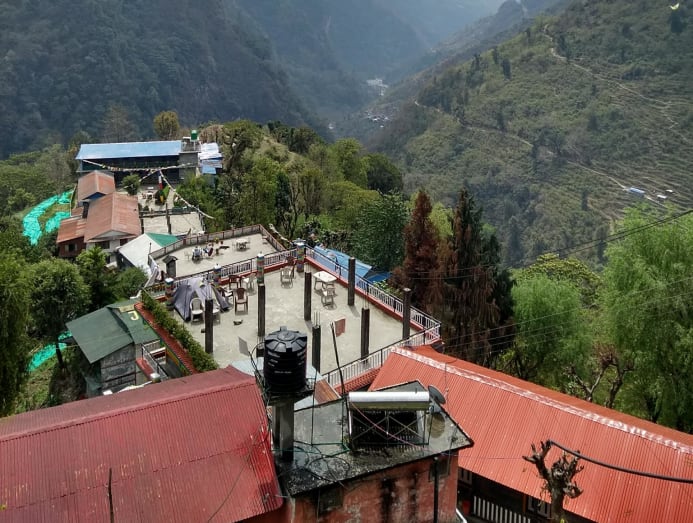
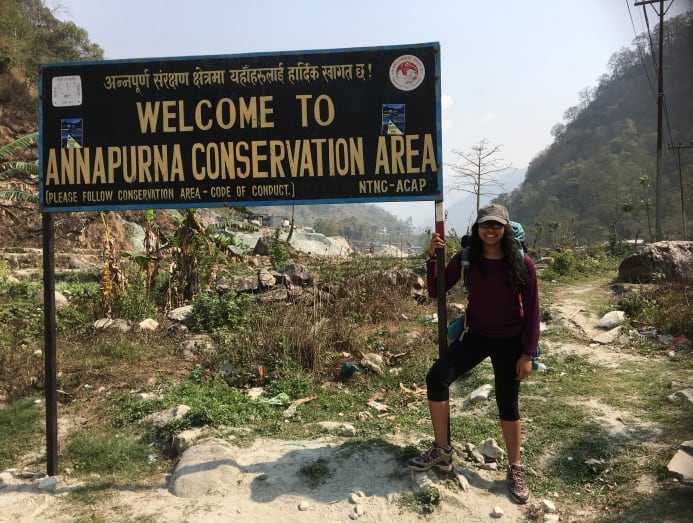
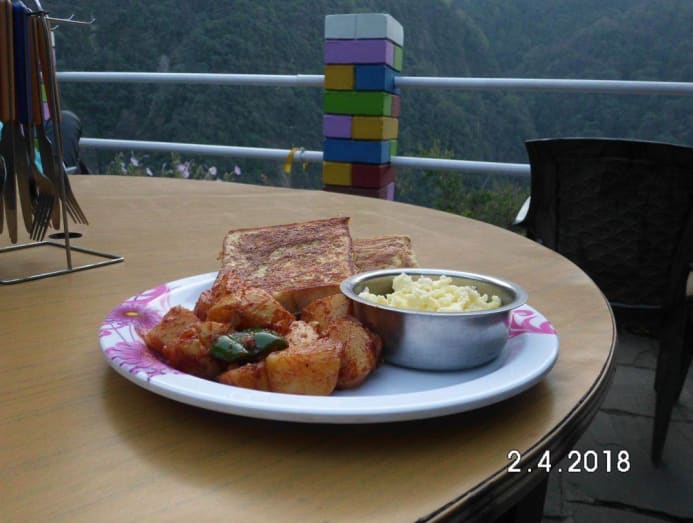
"Don't worry near information technology – I tin can acquit my pocketbook!" I told Raj in the get-go few minutes of my expedition. This resilience wore sparse by the first slope I encountered and I handed it over to Raj, begrudgingly.
Hiring a porter is probably a wise choice if you're not used to walking for hours with all your belongings on your dorsum. According to Raj, porters are oft only paid about United states of america$10 (Southward$xiii.5) a day for the laborious work that they do. I made a mental note to tip Raj generously at the stop.
Before long, a friendly lady at our lunch spot asked if I would similar a lemon cordial drink. "Aye," I answered, parched and in desperate need of a refreshing drink.
The residue of the day went by smoothly, and I even conquered 3,500 stone steps – each about twice the meridian of regular steps – that took about two hours to complete.
At this signal, we were only most 1,960m above sea level, merely the views the Himalayas provided were breathtaking. From the snowy peaks of the Annapurna range in the horizon to the imperial mountains emerging from behind the gravel and copse that lined the trekking routes.
The adjacent morn, I could not stand up from my bed without experiencing excruciating abdominal pains.
Water CONTAMINATION AND THE KINDNESS OF STRANGERS
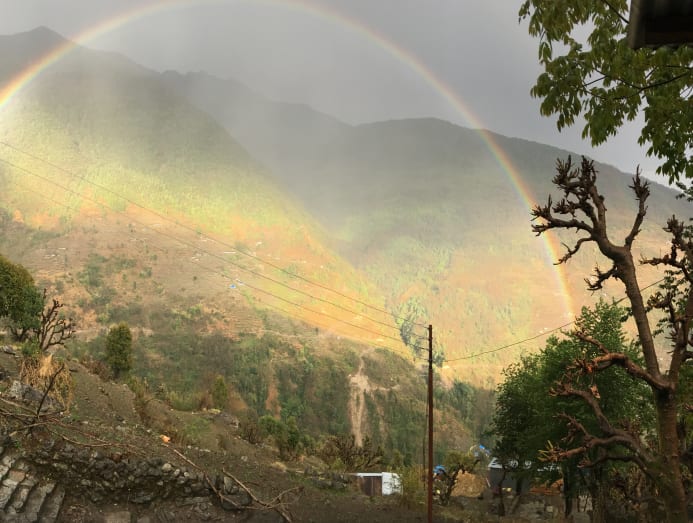
The first lesson of the day: Be gung-ho – but not gung-ho enough to drink unclean h2o without using water purification tablets. The lemon cordial had been mixed with regular tap h2o and the village doctor informed me that it was a example of water contamination.
In fact, most guest houses on the trek offering "condom drinking water" for a minor toll.
Information technology was a harrowing experience, but I likewise learned how hospitable the Nepalese are.
Imagine a dishevelled, half-dazed girl holding tree branches (they were replacements for actual trekking poles considering I did non plan ahead to buy a pair), barging through your front door, asking to take a nap on your bed because she can't walk any further without fainting.
Personally, I would have turned away my ain reflection, going by how crazed I looked, simply a compassionate lady along our trek to Ghorepani opened her doors and ushered me into her hut, where I promptly brutal comatose for about an hour.
With a little more free energy afterwards my nap, I pressed on with my trek for the day that took 8 hours to complete, twice as long as information technology normally takes because that's how ho-hum I was going, given my abdominal pains. But I listened to a piece of sound advice given by a friend before my trip: Heed to your body and go at your own pace.
I was determined to make the third day better. Too, I had at least four more than days to consummate the ascent and I could not permit myself stop now. The fact that I had paid US$670 for the trek was also a factor. Of course, halfway upwards my trek to Poon Hill to lookout the sunrise, I started finding it harder to breathe.
It was the dreaded distance sickness – a condition that had caused many other trekkers I met in my hostel to halt their trek midway. Some trekkers I would run into higher up on the trail even hired a helicopter for U.s.$2,500 to ferry them back to Pokhara after a bout of intense altitude sickness.
Symptoms of altitude sickness include shortness of breath, nausea, headaches and fatigue, and information technology commonly occurs 3,200m in a higher place ocean level.
I popped a few Diamox pills immediately to prevent the altitude sickness from escalating, and continued forward.
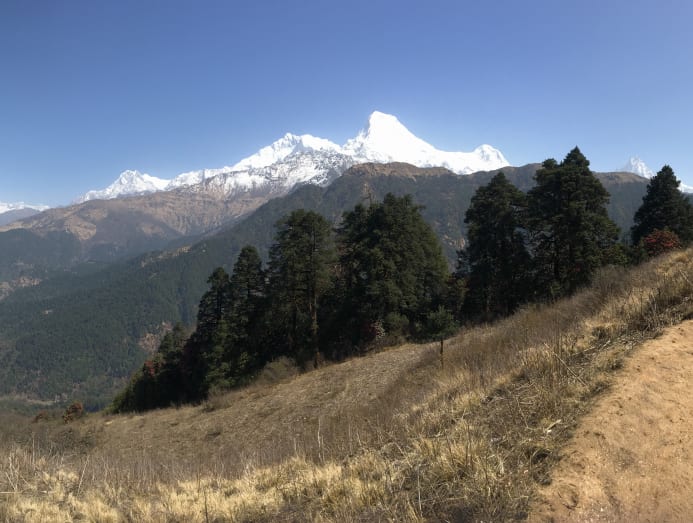
THE Last ASCENT
As the days went by and nosotros inched closer to the summit, I began to recover from water contamination and the altitude sickness with the help of my array of medication.
"Left, right, left, right," the voice in my caput barked, forcing me to place ane foot in front of the other to go along walking because this was the only way to forget the fatigue plaguing every muscle in my legs.
On the final leg of the ascent, I found myself ankle-deep in snowfall at 4am, blanketed past heavy darkness. I struggled ahead, making the almost of my iPhone'due south flashlight to see where I was going.
After clumsily trudging up the snow for nearly two hours and occasionally slipping on ice sheets, the silhouette of a sign in the distance brought actual tears to my eyes.
It read: "Congratulations! Nosotros achieved Annapurna Base Military camp."
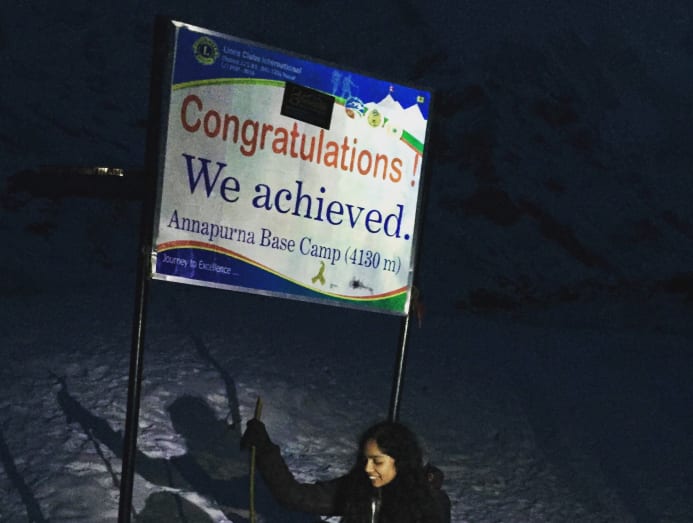
As the dominicus rose subsequently that morning, the sheer magnificence of the situation revealed itself. Annapurna Base of operations Military camp boasts a 360-degree view of the larger-than-life Annapurna range, comprising peaks similar the Annapurna I, Annapurna South and Gangnapurna. Behind me stood the Machapuchare, an untouched mountain with a razor-sharp peak.
No matter where I turned, a towering mountain stood confronting the dazzling glare of the sun with pure, white snow cascading down its jagged edges. Information technology was a stunning natural beauty.
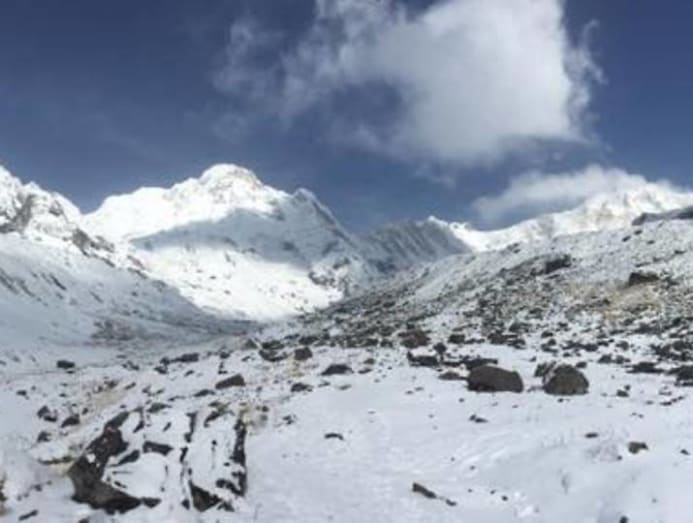
I was humbled. I had seen the Himalayas in all its glory, and I had been treated to the kindness of fascinating strangers. Information technology was non at all piece of cake, only this test of my willpower reminded me why I put myself in situations like this, alone in a foreign country: Because getting out of your comfort zone is daunting, merely equally as rewarding.
But maybe next time, a little planning won't hurt.
***
LEARN FROM A ROOKIE TREKKER'S MISTAKES: 5 TIPS FOR FIRST-Time TREKKERS
one. Railroad train AND TRAIN SMART
Even if you are a natural athlete, y'all take to ensure that your cardiovascular abilities are upwards to walking uphill for hours on finish daily during your ascent. Practising on an elliptical or stride machine volition aid, only if going to the gym is not an choice, climbing up the flights of steps in a building is an economic alternative.
ii. BUY PROPER GEAR
A proficient pair of trekking shoes should take a good grip that is appropriate for the terrain you lot will be trekking on. Break in your shoes in accelerate so you don't become blisters.
Trekking poles help with rest and take some pressure level off your knees, specially if you lot take to bargain with slippery terrain or snow.
Finally, a waterproof and windproof downwardly jacket can go a long mode in keeping you toasty.
3. GET THE Correct MEDICATION
In some remote areas, information technology may be most incommunicable for emergency vehicles to reach you mid-trek, and your just pick is to charter a pricey helicopter to ferry you back downward.
Pack distance sickness medication and water purification tablets. Charcoal pills are handy in case of food poisoning and paracetamol for when a nasty headache or pesky cold creeps up on you.
4. PACK Half OF WHAT YOU THINK YOU Demand
While taking a shower daily is ideal, it may not exist viable during a trek. My bag would have been considerably lighter had I packed fewer dress and shower products. For hygiene purposes, yous should probably bring disposable underwear with you, but for everything else, trust in the power of deodorant and dry shampoo.
5. RESEARCH, RESEARCH, Research
Find a guide from a reputable trekking bureau – it guarantees that you're always with someone who knows what to do in case of an emergency.
Inquiry the trek that is best for you. Do not assume the shortest trek is the easiest. The trek to Annapurna Base of operations Camp may be shorter, but it involves a series of uphill and downhill routes. The longer trek to Everest Base Military camp, on the other hand, while seemingly daunting because of the give-and-take "Everest" in it, is a gradual uphill ascension.
Source: https://cnalifestyle.channelnewsasia.com/lifestyle/trekking-nepal-himalayas-solo-travel-beginner-tips-215396
Postar um comentário for "Trekking the Himalayas on a whim – alone and with no plan"